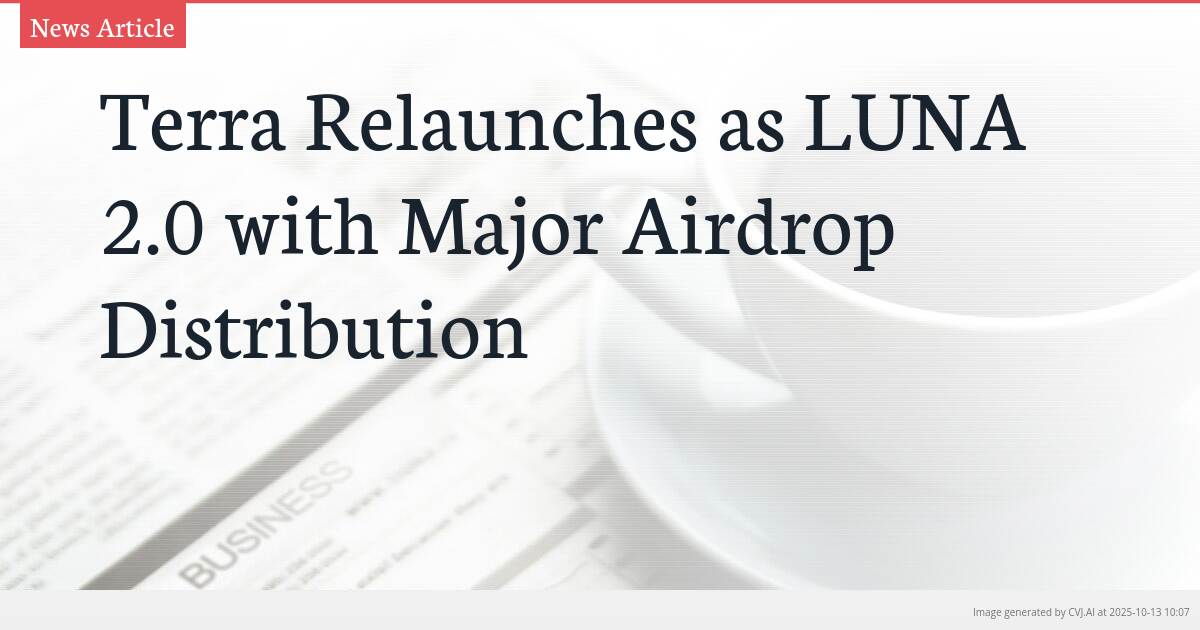This summary text is fully AI-generated and may therefore contain errors or be incomplete.
Introduction
Terra has officially relaunched with a new blockchain and LUNA 2.0 token following its spectacular collapse, marking one of the most ambitious recovery attempts in cryptocurrency history. The revival includes a massive airdrop distribution to previous token holders and major exchange listings, though the project faces significant skepticism from investors burned by the original ecosystem’s failure.
Key Points
- The new Terra blockchain launched without UST stablecoin, with LUNA 2.0 replacing the original token while Terra Classic (LUNC) represents the old chain
- Airdrop distribution allocates 30% to community development pool, 35% to pre-attack LUNA holders, and includes vesting schedules where holders of over 10,000 tokens receive only 30% immediately
- Major exchanges including Binance, Huobi, and Kraken have listed LUNA 2.0, which initially traded around $9 amid significant selling pressure and investor skepticism
The Phoenix Protocol: Terra's Controversial Rebirth
In one of the most dramatic resurrections in crypto history, Terra has returned with a completely new blockchain architecture following the catastrophic collapse that wiped out billions in investor value. The revival, spearheaded by Terraform Labs founder Do Kwon, represents a fundamental restructuring of the entire ecosystem. The new Terra blockchain launched without the UST stablecoin that precipitated the original collapse, instead focusing on a redesigned LUNA token now branded as LUNA 2.0.
The original LUNA token has been rebranded as Terra Classic (LUNC), while the new Terra (LUNA) represents the fresh start. This bifurcation creates a clear separation between the failed legacy system and the redesigned network. All decentralized applications and assets previously operating on the old Terra blockchain must now migrate to the new network, presenting both technical challenges and strategic opportunities for developers and investors alike.
The Airdrop Mechanics: Distribution and Vesting Strategies
Central to Terra’s revival strategy is the LUNA 2.0 token airdrop, which has become one of the most widely contested topics in the crypto industry. The distribution follows a carefully calibrated allocation: 30% goes to the community pool for development, 35% to pre-attack LUNA holders, 10% to pre-attack UST holders, 10% to post-attack LUNA holders, and 15% to post-attack UST holders. This weighted distribution aims to balance compensation for original investors with resources for future development.
The community pool, managed by Terra governance, has already allocated 30 million of its total pool value to developers committed to rebuilding on the new Terra chain. To prevent immediate selling pressure that could destabilize the new token’s price, the distribution includes sophisticated vesting mechanisms. Investors holding more than 10,000 tokens receive only 30% immediately, with the remaining 70% distributed over two years. Those with over one million tokens face even stricter conditions, waiting one year for distribution followed by a four-year holding period.
Claiming the airdrop is available through both centralized exchanges and Terra’s official website. Major cryptocurrency platforms including Binance, Huobi, and Kraken have announced support for the distribution, providing multiple channels for eligible holders of Luna Classic (LUNC), TerraUSD Classic (USTC), or Anchor Protocol UST to access their new tokens.
Market Reception and Trading Infrastructure
The new LUNA 2.0 token has already gone live on numerous major exchanges, creating immediate liquidity and trading opportunities. The listing roster includes industry giants like Binance, Huobi, Kraken, FTX, Gate.io, OKEx, Bitget, KuCoin, Lbank, HitBTC, itMart, WhiteBIT, BKEX, and MEXC Global. This broad exchange support demonstrates significant infrastructure backing despite the project’s controversial history.
Initial trading saw LUNA 2.0 priced around $9 following a massive dip from its launch levels, reflecting both cautious optimism and significant selling pressure. The token’s accessibility extends beyond crypto-native platforms, with support for fiat currencies including USD, CAD, EUR, PHP, INR, and IDR, potentially broadening its investor base beyond the crypto-savvy.
Investor Sentiment and Future Prospects
The Terra revival faces substantial skepticism from an investment community still reeling from recent losses. Many investors have lost trust in the Terra ecosystem entirely, creating persistent selling pressure on the new chain. According to feedback from genuine Terra and LUNA owners, the airdrop has allowed some to recuperate only a decimal-place proportion of their initial investment, highlighting the massive value destruction from the original collapse.
The fundamental role of the new LUNA token has shifted significantly. Without the UST stablecoin mechanism that defined the original ecosystem, LUNA 2.0’s primary function is to regulate the ecosystem through governance and network security. This represents a fundamental departure from the algorithmic stablecoin model that previously drove both growth and eventual collapse.
Do Kwon’s new venture faces the dual challenge of technical execution and reputation rehabilitation. While the structured distribution and exchange support provide a foundation for recovery, the project must overcome deep-seated investor skepticism and prove its long-term viability in a market that remembers all too well the spectacular failure of its predecessor.
📎 Read the original article on coincodecap.com

